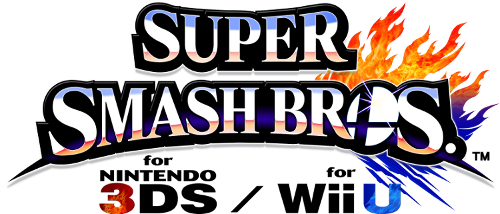
Introduction
Super Smash Bros. for 3DS and Wii U is the fourth fighting game in the Super Smash Bros. Series by Nintendo for the Nintendo 3DS and Wii U.
Characters
|
Game Mechanics
Mechanics of Smash
As a platform fighter, Smash Bros. functions quite differently from other fighting games.
- Movement and stages: Fighting takes place on a two-dimensional plane, typically with platforms (sometimes moving ones) and, in rare cases, environmental hazards. Characters move freely, looking either direction at any given time. Every character has at least two jumps; some, like Kirby and Pit, have more. This doesn't count the extra jump in many characters' up specials. When jumping from the ground, the character can perform short or full hops, similar to SNK fighters.
- Health: Replacing the typical HP seen in fighting games is a percentile for players. Taking damage builds up this percent, and the further these percents scale, the further that certain attacks will launch them. The goal is to knock the opponent off one of the sides of the screen (can be top, sides or bottom). If a character hits the edge of the battlefield (typically called a "blast zone"), there will be a giant flash and said character will lose their stock, returning to the battlefield with a reset percentile. A player loses the game when they have lost their last stock, or they have fewer stocks (points in timed matches) when the time runs out.
- Attacks: Every character has a standard attack (jab), three strong attacks ("tilts"), three Smash attacks, and five aerial attacks, all of which are used using the attack button (typically the A button on most controller schemes). Every character also has four specials, along with a grab and four directional throws. Players may also attack on wakeup or when getting up from the ledge.
- Shield: Smash has a dedicated shield button (typically the L or R buttons, which function identiacally by default) which acts as the blocking mechanic for this game. Shields can withstand up to 42 damage, but are also drained over time as they are used, regenerating when not in use. Blockstun is calculated based on how much damage the shield takes. Some moves have bonus shield damage modifiers. When a shield runs out, the player is stunned and temporarily unable to act, which usually leads to them losing the stock or the game.
- Other evasive maneuvers: Dodges come aplenty in Smash. There is the standing dodge (down + shield), rolling dodge (left or right + shield), and air dodge (shield when in the air). Each has its own recovery time. Downed players may wakeup in place, or by rolling left or right.
- Directional influence: DI is a mechanic that allows a character to slightly alter their knockback direction based on the direction they held when they were hit. This is integral for improved survival against far-launching blows that have the potential to KO. Mixing up DI is also important to escape some strings, combos, and 50/50s. Another kind of DI (called SDI, or hitstun shuffling in-game) shifts the character's position slightly upon getting hit; this requires precise timing in order to be effective, but is easier to do on multi-hit attacks.
Specific to Smash 4
- Transformations removed: Characters can no longer transform into other characters mid-match. Zelda and Sheik are now separate characters, as are Samus and Zero Suit Samus.
- Rage: Rage is Smash 4's native comeback mechanic. Depending on how much damage a character has sustained, the knockback on their attacks will steadily increase. Rage bonuses will first be felt at 35% damage taken, and continue to scale until they reach 150%. Although this results in earlier kills in numerous situations, it can work against combo characters like Fox, whose combos stop working as a result of the moves launching the opponent too far for the moves to link.
- Ledge invincibility and trumping: In previous Smash games, characters could repeatedly grab the ledge to refresh the temporary invincibility they get while hanging onto it. They would not be able to grab ledges that already hosted another character. This changes in Smash 4, with ledge invincibility no longer refreshing unless the character lands on the ground or gets hit, and with characters effectively stealing the ledge from those already hanging from it; the trumped character is thrown a short distance away from the ledge. It's possible for a character to steal the ledge and then hit the trumped opponent before they can move again, making this an optimal way to edgeguard some characters.
Tournament Information
If you're playing in a Smash Bros. tournament, there are specific rules and guidelines that are followed. This section covers everything from rules to allowed stages to tier lists and more.
TBW